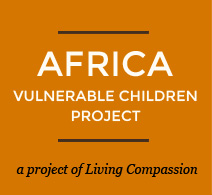Monday was an early start as Theresa and I had spent much of the weekend realizing all the things there are still left to do before I leave on Thursday. We started the day at the chitenge shop where we needed to buy more fabric for Martin. I also wanted to teach Pauline and Theresa what kinds of chitenge tend to be most popular so they can help pick out patterns when we are not here. The chitenge choices are constantly changing, and you are not likely to find the same fabric from one month to the next.
While at the shop I received a phone call from Norma, a reporter from the Times of Zambia. Mr. Kayula had gone to the Times office to tell them of our garbage collection program, and Norma was calling me to follow up. She told me they planned to run a short story on the project in the next day’s paper and to send a photographer out to take pictures on Wednesday when the garbage trucks were scheduled for their first pick-up. Our team—Theresa, Mr. Kayula, Pauline and I—shared a big chuckle that Living Compassion would make its media debut in Zambia.
After we finished at the chitenge shop we headed out to Kantolomba to check in on the garbage collection program. In the plan we had laid out with the community on Saturday the collection was to begin on Monday morning. There was to be a person stationed at each of the four collection points taking down names of the people who brought a tub full of trash so we can later hand out the 100 kwachas. When we arrived there was no one at points one, two or three and only a bit of trash collected at point four. It was interesting to note how unfazed I was at the seeming complete failure of the project thus far. I realized that our work in Africa has been a great teacher in not making assumptions. I had no idea why people were not collecting trash. It could be one of so many reasons. Instead of jumping to “this isn’t working,” I decided just to sit down with the team and see what they thought.
A group including the Coordinator, Theresa, Beauty and several other local women sat in the schoolyard and talked. Beauty and the other women do not speak English so Theresa translated. There were numerous theories about what was not working with the trash program: people weren’t interested, 100 kwacha per bucket was not enough, they hadn’t understood what was communicated at the meeting on Saturday. Most of us agreed that if people were not interested in helping because 100 kwacha was not enough, then we were not interested in enticing them with more money. The project is meant to be a community effort, not a fee-paying transaction. We decided to have Beauty and the Coordinator go around the compound that evening and explain again where the four trash drop-off points are, and that residents could bring the garbage anytime tomorrow (Tuesday) or Wednesday. We figured whoever participates participates, and if it doesn’t work we will come up with a new strategy.
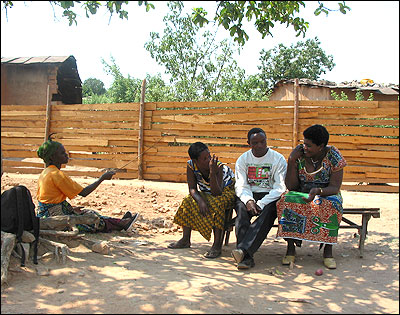
Again, I felt the benefits of having a team of Zambian folks to work these things out with and took the opportunity to get input on how best to go about handing out the black plastic for the roofs. I had a concern that there would be mayhem, with people complaining that they wanted their plastic right away and why did their neighbor get it first. At the same time, we did not have a place to store all 47 roles of plastic at one time so we had to do it in stages. It was decided that Beauty and the Coordinator would explain to people that the handouts would begin on Wednesday and that it would continue over the next 10 days until everyone had received his/her piece of plastic. It seems as long as the information is clear, people are satisfied.

Measuring plastic
We had the donated backpacks in the car and decided this would be a good time to hand them out as the children’s school day was ending. While the students were in the classroom, we brought the backpacks into the schoolyard. The teachers brought the children out 4 or 5 at a time to collect their new treasure. It was fun to watch each one receive it. Over time we are beginning to know the children and to see their various personalities. Some were immediately excited, others more reserved, almost stunned perhaps. Once each child had a backpack, we went into the classroom. The children were all very busy opening and closing the zippers, exploring all the compartments, and comparing notes with their friends. They all wanted the straps to be tightened to fit their shoulders so Theresa, the teachers, and I spent the next 15 minutes tending to each child. I found it a pleasure to have a few brief moments to be with one child at a time.
 |
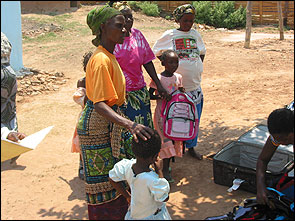 |

Before leaving Kantolomba we stopped by the RDC office to talk with the Chairman about the land purchase. We made a plan to meet the next day at 10 hours to sign the papers. We are soon to become homeowners in Kantolomba!
It was still only just past 11:00 so we headed back into town to do more errands before lunch. First we went to the bank to receive a money wire sent by the Living Compassion U.S. folks to enable us to pay for all these many things our team here is accomplishing. While at the bank, we spoke with a very friendly teller to whom we explained we needed 2,000 100 kwacha notes. He thought we were crazy until we explained our trash clean-up program in Kantolomba. I projected he was eager to be part of making it happen and assured us he would have the bills ready for us the next morning.
Next we went off in search of a good driving school for Theresa. With her growing responsibilities with Living Compassion, she will become the primary driver of the Living Compassion vehicle. We had heard good things about the Classic Driving School and decided to start there. The woman behind the desk was quite friendly though not able to answer many of our questions. She explained politely that today was her first day on the job. She suggested we come back when the driving instructor himself was around. We agreed.
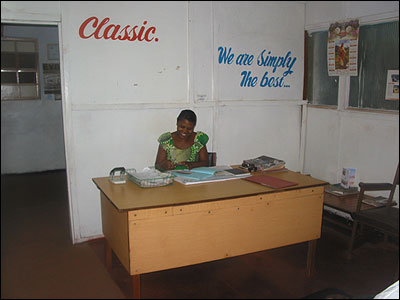
Finding ourselves with a few free minutes before lunch, we went to Elvis’s school to pay his tuition fees. The man in charge of collecting fees was in class at the time, and since we did not want to be late for our lunch meeting we decided to return another day. (There is much returning-at-another-time in Zambia.)
Theresa, Pauline, Mr. Kayula and I met at the Starscape Restaurant for lunch. It was a fabulous meeting in which we walked step by step through the document outlining the job responsibilities for the Zambian team. It is a pleasure to work with a group of people so willing and adaptable. It was helpful, too, for us to see some holes in the document and still have a few days to fill them in before I go.
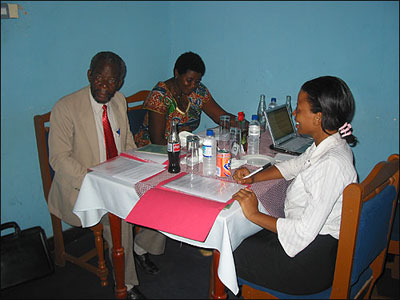
After lunch Theresa and I went to Steve’s office to see the site plan he and Nobel had drawn up after our visit to the new Kantolomba property. It was a very simple plot plan drawing but somehow seeing it ignited the realization that this is all really happening. We are purchasing a property; we are building a community center. The things we have been planning for months and years are here. We marvel regularly at the giant leaps the work has taken during this short visit.
Three-quarters of the way through the meeting, Theresa excused herself saying she didn’t feel well and that maybe lunch hadn’t agreed with her. I walked out several minutes later looking for her and found she had thrown-up several times. By that time she was feeling better and sitting with a cold cloth someone had brought her. It was one of those moments of being acutely aware of not being on my own turf. Do we wait and see if it passes or should we seek immediate medical attention? Where? I immediately phoned Pauline to see if she had gotten sick, as she and Theresa had eaten the same meal. Pauline was feeling fine so we could likely rule out severe food poisoning. Separately, Theresa, Pauline, and Steve all mentioned high blood pressure as a cause for vomiting, and we decided to go to a clinic to have Theresa’s blood pressure taken. We went to a clinic located downtown, run by a doctor friend of Gershom’s.
When we got to the clinic, I explained to the receptionist what was happening and that we thought we might check Theresa’s blood pressure. She told us the fee for a blood pressure check (less than 2 dollars), took our money, and whisked Theresa away for the test. Less than two minutes later Theresa was back with a normal reading. The medical system seems to be more like a restaurant than clinic here.You tell them what you would like to be tested for and they do it. Doctors and nurses are a scarce resource and, thus, they seem to avoid medical examinations. A few days before we had talked about this same issue with Georgina, the teacher in Kantolomba who has a newborn baby. She had taken her infant to the clinic with a cough. They had simply asked Georgina to describe the baby’s symptoms and, based on that, gave her cough syrup and sent her home.
We decided to have Theresa rest and see how she did. Gershom took her home, and I went to the Savoy to meet with Elvis and Pauline. When I had talked with the team about Elvis at our lunch meeting, everyone agreed that the first step is to go to Elvis’s house and see for ourselves whether what he says is true—that he is an orphan supporting his younger siblings. From what we are told, everyone in Zambia has a “story.” Many are true, some are not. The team felt it was important to verify Elvis’s story before deciding what the next step might be. Pauline had agreed to meet with me and Elvis at the Savoy to tell him we would like to come visit his house.
Elvis was very agreeable, even eager, to have us come visit him at home. I was running out of time so he and Pauline arranged to go his house on Wednesday morning.
I went across the street to the internet café to check email quickly before heading home. We will be so grateful when we once again find a way to use a high-speed internet connection. When Gershom came to pick me up, I realized there was little food left in the larder back at the Guest House, and I mustered the willingness to face ShopRite at prime rush hour. Being a store that caters to those well employed, ShopRite is most busy around 18 hours (6:00 PM) after people end a traditional workday. The checkout lines are 8 to 10 people deep. It is times like these when I remember how blessed we are back at the Monastery to have a team—someone cooking, someone cleaning, someone checking email, someone facilitating, everyone doing their part to make it all work.
I arrived home exhausted, but nothing meditation and a baked good by Douglas couldn’t take care of. Ready to begin again.
